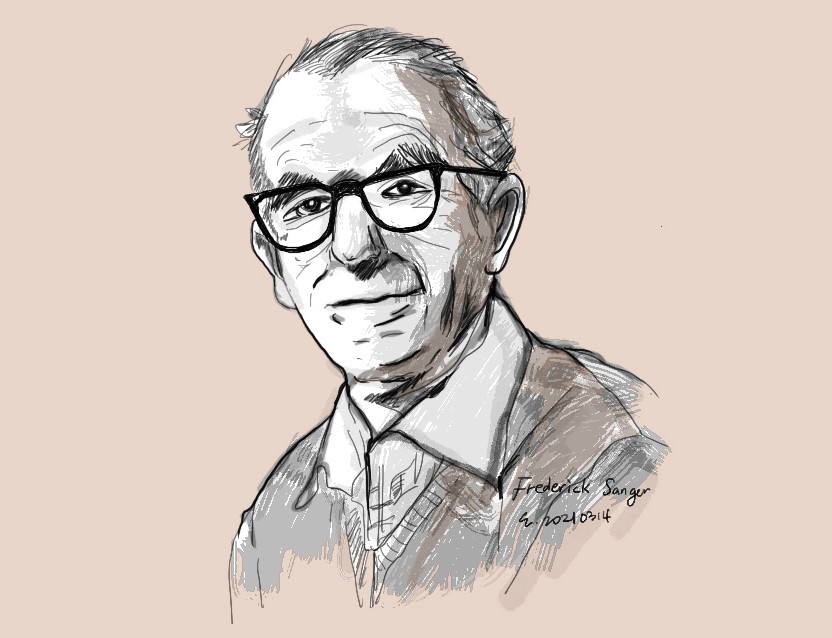Frederick Sanger is a genius who has won the Nobel Prize twice, which is difficult for others to receive. He was honored with the Nobel Prize in Chemistry at the young age of only 40 for his research on the structure of insulin.
Dorothy Hodgkin is a willing scientist who began researching insulin at the age of 24 and uncovered the three-dimensional structure of insulin after 35 years. Dorothy Hodgkin also won the Nobel Prize in Chemistry for his research on biomolecular structure.
Frederic Sanger reveals insulin amino acid sequence
Frederick Sanger’s first Nobel Prize was awarded for his first interpretation of protein sequences. The first protein he interpreted was’insulin’. Insulin is a protein composed of 51 amino acids.

Frederick Sanger contributed to the advancement of molecular biology and genetic engineering. Ⓒ Kim Eun-young/ ScienceTimes
Sanger used the Sanger method in 1955 to figure out the structure of insulin in cattle. He correctly identified the amino acid sequence of insulin. Bovine insulin has 48 identical amino acid structures and 3 different amino acid structures of human insulin.
When it comes to insulin, it is automatically reminded of diabetes. When food enters the body, insulin is responsible for absorbing sugar and lowering blood sugar. If your insulin doesn’t function properly, you’re more likely to develop diabetes.
Diabetes is the main culprit that causes serious complications such as myocardial infarction, stroke, and blindness. Insulin treatment is now readily available, but before insulin was mass-produced, many people were amputated or lost their lives.
Previously, insulin from animals such as cattle and pigs was used. Insulin in cattle and pigs has a problem such as side effects because the amino acid structure of human insulin is different. However, as Sanger identified the amino acid sequence of insulin, in 1978, human insulin was developed using a genetic recombination method, and it was possible to solve the side effects of insulin previously obtained from cattle and pigs.

Frederick Sanger and Dorothy Hodgkin have contributed significantly to the development of diabetes treatments, including chemical insulin synthesis. (Photo = Insulin treatment for diabetes treatment)
Sanger challenged the study of DNA following the study of protein. DNA is a generic term for substances that carry genetic information. Sanger won the second Nobel Prize in Chemistry by developing a technology to read the nucleotide sequences of A (adenine), T (thymine), G (guanine), and C (cytosine) that make up the structure of DNA.
His achievements in deciphering the sequence of DNA to enable the Human Genomics project have become a valuable foundation for advances in advanced biology, modern chemistry, and genetic engineering today.
Insulin research 35Dorothy Hodgkin completed in years
If Frederick Sanger, who identified the amino acid sequence, the primary structure of insulin, is a genius who identified the tertiary structure of insulin, that is, the three-dimensional structure. Dorothy Hodgkin analyzed the structure of insulin through X-ray crystallography. X-ray crystallography is a method of finding the three-dimensional structure of a compound using X-ray diffraction.

Dorothy Hodgkin has completed the insulin molecular structure that he wanted to reveal at the age of 24 in 35 years. Ⓒ Wikimedia
Hodgkin’s relationship with insulin dates back to 1934. Hodgkin, who was 24 at the time, succeeded in taking insulin crystals with X-ray diffraction images. However, it was not easy with the technology at the time to unravel the structure of insulin.
Hodgkin was eager to find the structure of cholesterol as an extension of insulin research. The study led to the study of penicillin, and then the molecular structure of vitamin B₁₂ consisting of about 100 atoms was revealed using X-ray spectroscopy. Hodgkin won the Nobel Prize in Chemistry in 1964.
After winning the Nobel Prize, Hodgkin returns to Oxford University in the UK to continue the insulin research he studied at the age of 24. At that time, Hodgkin was suffering from severe rheumatoid arthritis due to numerous repeated experiments since childhood. His hand was damaged enough to make it difficult to operate the X-ray mechanical switch. However, Hodgkin did not give up his dream of finding out the structure of insulin when he was young.
In 1969, he finally analyzed about 70,000 spots on an X-ray photograph to fully clarify the three-dimensional structure of insulin. It was the product of tenacity achieved in 35 years.
Frederick Sanger and Dorothy Hodgkin devoted their lives to the study of molecular structure. They have contributed significantly to the development of diabetes treatments, including chemical insulin synthesis. Thanks to their persevering research that took their lives, we are able to advance the research of many kinds of biopolymers, including proteins.
(823)
